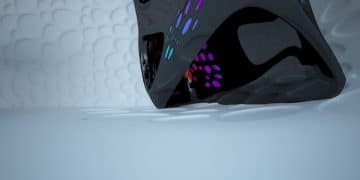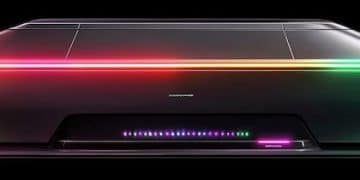How 2025’s New Ray Tracing Tech Will Boost Gaming Performance by 35%

The emergence of new ray tracing technologies in 2025 is poised to significantly enhance gaming visuals and performance, potentially delivering up to a 35% improvement in rendering efficiency and immersive realism for players through advanced hardware and software integrations.
The gaming landscape is perpetually evolving, pushing the boundaries of visual fidelity and immersion. As we look towards 2025, a significant leap forward is expected with the advent of new ray tracing technologies, promising to fundamentally alter how games look and perform. This article delves into how 2025’s new ray tracing tech will impact gaming performance by 35%, exploring the underlying innovations and what this means for the future of interactive entertainment.
The foundational shift in rendering technology
The journey of rendering technology has been one of continuous refinement, moving from blocky pixels to photorealistic environments. For years, game developers relied on rasterization, a method that translates 3D models into 2D images by projection. While effective, rasterization often struggled with accurate light simulations, requiring numerous workarounds like pre-computed ambient occlusion maps and screen-space reflections, which, while visually convincing, lacked true physical accuracy.
Ray tracing, on the other hand, fundamentally changes this paradigm. Instead of projecting polygons, it simulates the path of light rays, much like how light behaves in the real world. A ray is traced from the camera through each pixel into the scene, interacting with objects, reflecting, refracting, or absorbing light, and then bouncing off surfaces. This allows for incredibly realistic shadows, reflections, refractions, and global illumination, all computed in real-time. The computational load, however, has historically been immense, limiting its widespread adoption beyond professional rendering applications.
From concept to consumer: the early days of ray tracing in games
The initial foray of ray tracing into consumer gaming began with specialized hardware and APIs, like NVIDIA’s RTX series and Microsoft’s DirectX Raytracing (DXR). These early implementations demonstrated the potential, but also highlighted the performance challenges. Games often saw significant frame rate drops when ray tracing was enabled, necessitating compromises in resolution or detail. This era served as crucial groundwork, providing developers and hardware manufacturers with invaluable data and experience to optimize the technology further. The 2025 advancements are built upon these early lessons, leveraging more efficient algorithms and dedicated hardware.
The promise of next-generation hardware acceleration
The core of the anticipated 35% performance improvement in 2025 lies in the continued evolution of hardware acceleration. Graphics processing units (GPUs) are being designed with more powerful and specialized ray tracing cores, capable of handling the complex calculations with unprecedented speed. These next-generation architectures aren’t just about raw compute power; they’re about intelligent design, optimizing the data flow and parallel processing required for real-time ray tracing. This architectural refinement is critical for bridging the gap between photorealism and playable frame rates.
* Dedicated ray tracing blocks within the GPU architecture.
* Improved memory bandwidth and cache hierarchies.
* Enhanced power efficiency for sustained performance.
* Closer integration with AI-driven upscaling technologies.
The advancements aim to make ray tracing not just an option for high-end systems, but a standard feature accessible across a wider range of gaming hardware, democratizing cinematic visuals.
The foundational shift from traditional rasterization to advanced ray tracing is about more than just visual upgrades; it’s about a fundamental change in how light and shadows are processed within a virtual environment. The early years laid the groundwork, and the innovations expected by 2025 are set to deliver on the long-held promise of real-time photorealism in gaming, making it a viable and impactful technology for the mainstream.
New algorithms and software optimizations
While hardware evolution is undeniably critical, the software side plays an equally pivotal role in realizing the 35% performance boost. The ingenuity of developers and researchers in crafting more efficient algorithms and optimization techniques is what truly unlocks the potential of the underlying hardware. We’re witnessing a paradigm shift where brute-force computation is supplemented, and often surpassed, by smarter, more optimized approaches.
One significant area of progress lies in spatially and temporally intelligent denoisers. Raw ray tracing output is inherently noisy, as it’s based on sampling a finite number of light rays. Early denoisers often introduced visual artifacts or blurred details. By 2025, advanced denoisers will leverage machine learning and sophisticated temporal accumulation techniques to reconstruct clean, high-fidelity images with significantly fewer sampling rays, thus drastically reducing the computational cost per frame. This means games can achieve stunning visual quality with less rendering overhead.
Adaptive sampling and material simplification
Future ray tracing implementations will also benefit from adaptive sampling. Instead of tracing the same number of rays across the entire scene, algorithms will intelligently focus computational power on areas that demand higher precision, such as highly reflective surfaces or intricate shadows, while reducing ray counts in less critical areas. This dynamic allocation of resources ensures that performance is optimized without sacrificing perceptible visual quality. Complementing this, streamlined material definitions will allow developers to describe surfaces in ways that are more efficient for ray tracing calculations, reducing the complexity of light interactions.
* Machine learning-powered denoisers for cleaner images.
* Dynamic ray budgets based on scene complexity.
* Simplified material description languages for faster rendering.
* Optimized data structures for BVH (Bounding Volume Hierarchy) traversal.
These intelligent software innovations are crucial for maximizing the efficiency of the new ray tracing cores in GPUs. They allow the hardware to perform fewer redundant calculations, focusing its power where it matters most for visual fidelity. The collaboration between hardware and software engineers is key to achieving the targeted performance gains.
The role of AI and machine learning in rendering pipelines
Beyond denoisers, artificial intelligence and machine learning are increasingly integrated into various stages of the rendering pipeline. AI can predict light bounces, optimize scene geometry for ray tracing, or even intelligently cull objects that contribute minimally to the final image. This represents a move towards “smart rendering,” where the system actively learns and adapts to the scene, rather than relying on static rules. By offloading complex calculations or streamlining processes through AI, the overall performance of ray tracing is significantly improved, paving the way for the promised 35% boost.
The combination of sophisticated algorithms and a deeper integration of AI is transforming ray tracing from a demanding, niche feature into a scalable, performant technology. These software optimizations, hand-in-hand with hardware advancements, are the driving force behind the anticipated performance revolution in 2025.
The direct impact on visual fidelity and immersion
The quantitative performance increase of 35% isn’t merely a number; it translates directly into a qualitative leap in the visual fidelity and immersion offered by games. When ray tracing runs efficiently, it unlocks levels of realism previously confined to pre-rendered cinematics or static scenes. The way light behaves in a game world profoundly influences how believable and captivating that world feels.
Dynamic global illumination and environmental realism
One of the most transformative aspects of widespread, performant ray tracing is accurate global illumination. This refers to how light from discrete sources (like the sun or a lamp) bounces and reflects off surfaces to illuminate an entire scene, illuminating areas that are not directly lit. Traditional methods approximated this, but often fell short in dynamic environments. With advanced ray tracing, every object can accurately contribute to the scene’s lighting, creating more natural transitions between light and shadow, and ensuring that light dynamically reacts to changes in the environment, like a door opening or an object moving. This makes environments feel more physically grounded and alive.
* Realistic light propagation and color bleeding.
* Dynamic time-of-day lighting with authentic shadow transitions.
* Subtle ambient light contributions from all surfaces.
* Enhanced volumetric lighting effects like god rays and fog.
This level of lighting accuracy elevates environmental realism, making virtual landscapes and interiors feel more tangible and less like static backdrops.
Reflections, refractions, and true-to-life surfaces
The improvements in reflections and refractions are perhaps the most immediately noticeable benefits. Polished surfaces will display accurate reflections of the entire scene, not just what’s on screen. Water will realistically refract light, distorting objects beneath the surface in a physically correct manner. Glass and other transparent materials will exhibit true-to-life refractions and reflections, adding incredible depth and nuance. This level of detail in surface interactions vastly enhances the sense of realism, particularly in games with wet environments, metallic objects, or intricate interiors. The 35% performance boost means these effects can be rendered with less compromise, even in fast-paced action sequences.

Character and object believability
Beyond environments, ray tracing significantly impacts the believability of characters and individual objects. Accurate self-shadowing, intricate reflections on character eyes or metallic gear, and realistic ambient occlusion that precisely darkens crevices based on light interactions all contribute to a heightened sense of presence. Characters will no longer appear “floaty” or detached from their surroundings; they will be properly integrated into the lighting of the scene, with shadows falling correctly from their bodies onto the terrain and vice versa. This nuanced approach to character rendering ensures that the protagonists and antagonists inhabiting these visually rich worlds feel just as real as their surroundings.
Ultimately, the 35% performance impact of new ray tracing tech is about unlocking a deeper, more profound sense of immersion. It allows developers to craft worlds where every detail, from the glint in a character’s eye to the subtle shadows cast by swaying foliage, contributes to a cohesive and believable visual experience.
Beyond visuals: new gameplay possibilities
The advancements in ray tracing extending beyond mere visual enhancements, ushering in an era where lighting and environmental interactions can directly influence gameplay mechanics. This isn’t just about making games look better; it’s about making them play differently, opening up innovative design opportunities that leverage physically accurate light simulation.
One exciting gameplay implication is in stealth mechanics. Imagine a game where shadows are not pre-defined textures but are dynamically cast by every light source and moving object. Players could strategically manipulate light sources to create new hiding spots or to expose enemies. Conversely, enemies’ AI could become more sophisticated, using dynamic lighting and shadow patterns to detect players, adding a new layer of challenge and tactical depth. The 35% performance boost ensures these complex computations can occur without hindering the fast-paced nature of stealth gameplay.
Environmental puzzles and interactions
Ray tracing can also transform environmental puzzles. Puzzles might revolve around manipulating light beams, using reflective surfaces to redirect light to activate mechanisms, or solving riddles based on how light reveals hidden clues. For instance, a puzzle could require a player to angle a series of mirrors to guide a ray of light through a complex maze, illuminating a previously hidden symbol or opening a secret passage. This turns light itself into an interactive element, adding ingenuity to level design that was previously difficult or impossible to achieve with approximate lighting methods.
* Stealth mechanics leveraging dynamic shadow creation.
* Light-based puzzles requiring reflection and refraction manipulation.
* Environmental storytelling through realistic light and shadow interaction.
* Improved line-of-sight calculations in tactical scenarios.
These interactions enrich the gameplay loop, moving beyond simple trigger-based events to incorporate the nuanced physics of light within game mechanics.
Enhanced realism for simulation and strategy games
Even in genres not traditionally associated with visual spectacle, like simulation or strategy games, the impact of advanced ray tracing can be significant. Accurate light propagation can influence visibility in scenarios where line of sight is crucial, such as urban combat sim. Light and shadow can become key tactical elements, impacting unit placement or resource management. Furthermore, the sheer visual fidelity can enhance the player’s connection to the game world, even in a top-down perspective, making strategic decisions feel more grounded in a believable reality. The enhanced performance ensures that these calculations do not bog down large-scale simulations.
The integration of ray tracing into gameplay mechanics represents a maturation of the technology. It signifies a shift from a purely aesthetic upgrade to a functional tool for game designers, enabling richer, more interactive experiences that leverage the authentic behavior of light, creating new challenges and opportunities for players.
Addressing remaining challenges and the road ahead
The projected 35% performance gain by 2025 is a significant milestone, yet the journey of ray tracing isn’t without its continuing challenges. As with any cutting-edge technology, there are ongoing hurdles to overcome, primarily related to optimization, broader adoption, and ensuring a seamless experience across diverse hardware ecosystems.
One of the primary challenges remains optimization for lower-end hardware. While the 35% boost addresses high-end and mid-range systems, making ray tracing accessible on integrated graphics or older discrete GPUs is still a formidable task. Developers must find ways to intelligently scale ray tracing effects without completely sacrificing visual integrity or performance. This involves hierarchical rendering techniques and further refinement of selective ray tracing applications, where effects are applied only where they have the most visual impact, minimizing unnecessary computations.
Standardization and multi-vendor support
Another crucial aspect is the need for greater standardization and robust multi-vendor support. While DirectX Raytracing (DXR) and Vulkan Ray Tracing have moved towards a unified API, underlying hardware architectures still differ significantly between manufacturers like NVIDIA, AMD, and Intel. Ensuring that games can leverage ray tracing efficiently across all major GPU platforms without requiring extensive platform-specific optimizations is essential for widespread adoption and consumer confidence. Close collaboration between API developers, hardware manufacturers, and game studios is vital to streamline this process.
* Scalability for integrated and entry-level GPUs.
* Unified API development and cross-vendor hardware optimization.
* Education and tools for game developers to integrate ray tracing efficiently.
* Managing power consumption for mobile and portable gaming devices.
The industry is working towards more comprehensive SDKs and middleware that abstract away hardware specificities, making it easier for developers to implement high-quality ray tracing effects without excessive burdens.

Balancing visual fidelity with developer workload
Finally, there’s the perpetual challenge of balancing visual fidelity with developer workload. Implementing full ray tracing correctly requires significant artistic and technical effort. From meticulously crafted assets that react correctly to light, to debugging complex lighting scenarios, the overhead can be substantial. Future tools and pipelines need to simplify this process, potentially through AI-assisted asset creation or intuitive real-time debugging suites, allowing artists and designers to focus on creativity rather than optimization minutiae. The 35% boost helps alleviate some performance pressure, but ease of content creation remains a critical factor for wider adoption.
Addressing these challenges is an ongoing process that extends beyond 2025. However, the anticipated performance gains provide a strong foundation upon which further innovations and optimizations can be built, making ray tracing an increasingly ubiquitous and impactful technology in gaming.
Economic and market implications for the gaming industry
The projected 35% performance increase for ray tracing by 2025 is not just a technical footnote; it carries significant economic and market implications for the entire gaming industry. From hardware manufacturers to game developers and consumers, the ripples of this technological leap will be widely felt, shaping investment, development strategies, and consumer expectations.
For hardware manufacturers, this breakthrough reinforces the importance of investing heavily in R&D for next-generation GPU architectures. Companies that successfully deliver efficient and powerful ray tracing capabilities will likely gain a significant competitive edge. This drives innovation in silicon design, memory technologies, and power efficiency, leading to a new cycle of upgrades for consumers and potentially increasing market share for leading manufacturers. The 35% improvement could also open new market segments, as more gamers seek to experience these enhanced visuals.
Shifting development priorities and resource allocation
Game developers will also see a shift in priorities. With a substantial performance buffer, studios can reallocate resources that were previously spent on creative workarounds for lighting and reflections towards other areas, such as more complex AI, richer environmental detail, or innovative gameplay mechanics. The ability to achieve photorealistic lighting with greater efficiency means that development pipelines can become more streamlined, with less time spent on tweaking baked lightmaps and more on artistic expression and iterative design. This could lead to higher quality games across the board and potentially faster development cycles for certain aspects of visual design.
* Increased R&D investment in GPU technology.
* Higher demand for ray tracing-capable hardware.
* Shift in game development focus from visual workarounds to creative enhancements.
* New monetization opportunities through graphically advanced titles.
This technological advancement encourages studios to push visual boundaries, leading to more immersive and captivating gaming experiences that can attract new players.
Consumer expectations and market segmentation
For consumers, the 35% performance boost means that high-fidelity ray tracing will be more accessible across a wider range of price points. This will elevate consumer expectations regarding graphical realism and immersion. Games that offer fully ray-traced experiences will become the new benchmark, potentially segmenting the market between games that embrace this technology and those that adhere to older rendering paradigms. This could drive adoption of new hardware and create a stronger demand for games showcasing these advanced visuals. The overall perception of gaming as a leading entertainment medium will also be enhanced, attracting a broader audience.
The economic implications are clear: the 2025 ray tracing advancements will stimulate growth within the gaming hardware sector, enable developers to achieve higher fidelity with greater ease, and ultimately push consumer demand for cutting-edge experiences. It represents a significant inflection point, promising a more vivid and immersive future for gamers worldwide.
The future beyond 2025: what’s next for ray tracing?
While the 35% performance gain by 2025 marks a significant chapter in ray tracing’s evolution, it is by no means the final destination. The trajectory of this technology suggests a continuous journey towards even greater realism, efficiency, and integration into the broader digital landscape. Looking beyond 2025, we can anticipate several exciting developments that will further cement ray tracing’s role as a cornerstone of interactive media.
One major area of future development will be the complete integration of path tracing. Ray tracing, in its current form, typically focuses on specific effects like reflections, shadows, and sometimes global illumination through a limited number of bounces. Path tracing, however, simulates the full journey of light from its source to the camera, accounting for multiple bounces and complex light interactions with unparalleled accuracy. While computationally more intensive, continued hardware and algorithm advancements will gradually make real-time path tracing feasible for more games, leading to truly indistinguishable visuals from reality.
AI-driven content generation and procedural realism
The synergy between AI and ray tracing will deepen significantly. Beyond smarter denoisers, AI could be leveraged for procedural content generation that is inherently optimized for ray tracing. Imagine AI generating environments, textures, and assets that automatically respect the physics of light, creating vast, realistic worlds with minimal manual intervention. This could include AI that understands how different materials interact with light, generating surfaces that intrinsically look correct under a ray-traced rendering pipeline, saving artists tremendous amounts of time.
* Transition towards real-time, full path tracing.
* Deeper integration of AI for scene generation and optimization.
* Hardware-agnostic ray tracing solutions for broader adoption.
* Cross-platform consistency in visual fidelity.
This represents a future where the creation of highly realistic, dynamically lit environments becomes more accessible and efficient for developers of all sizes.
Democratization of ray tracing across platforms
Finally, the future beyond 2025 will see an even greater democratization of ray tracing across all gaming platforms. This includes not only personal computers and consoles but also mobile devices and cloud gaming services. As processing power continues to miniaturize and cloud infrastructure scales, real-time ray tracing will become a standard feature across the board, ensuring a consistent level of visual fidelity regardless of the device. This widespread availability will push developers to integrate ray tracing even more deeply into their fundamental game design, knowing that a vast majority of their audience can experience the intended visual fidelity.
The journey of ray tracing is indicative of the broader trends in computing: continuous optimization, increasing reliance on AI, and the relentless pursuit of realism. The 2025 milestone with its 35% performance impact is a stepping stone towards an even more visually stunning and immersive future for interactive entertainment, where the line between the virtual and the real continues to blur.
| Key Point | Brief Description |
|---|---|
| 🚀 Hardware Evolution | Next-gen GPUs with specialized cores for faster ray tracing calculations. |
| 🧠 AI & Algorithms | Smarter denoisers and adaptive sampling for efficiency. |
| 🎮 Enhanced Immersion | Realistic lighting, reflections, and shadows boost visual fidelity. |
| 💡 New Gameplay | Dynamic lighting enabling innovative stealth and puzzle mechanics. |
Frequently asked questions about new ray tracing tech
▼
Yes, dedicated ray tracing cores within GPUs will remain crucial for optimal performance in 2025. While software optimizations improve efficiency, these specialized hardware units are specifically designed to accelerate the complex calculations involved in ray tracing, making real-time, high-fidelity experiences possible without significant performance compromises.
▼
The 35% performance boost will primarily benefit new games released from 2025 onwards, designed specifically to leverage the new technologies. While some current-gen games might receive patches to utilize new optimizations, the most significant improvements will be seen in titles developed with these advanced ray tracing capabilities in mind from the ground up to maximize the new hardware and software efficiency.
▼
While not every single new game will necessarily have full ray tracing by 2025, the increased performance and efficiency will make it a more common and expected feature, especially in AAA titles. Developers will be more inclined to integrate it given the reduced performance impact and enhanced visual realism it offers, pushing it towards becoming a standard in high-fidelity experiences.
▼
Beyond 2025, A.I. will deepen its role in ray tracing, moving beyond just denoisers. It could be crucial for intelligent content generation, optimizing scene geometry on the fly, and even potentially simulating light behavior more accurately with fewer rays. A.I. will enable even more realistic and efficient rendering, making ray tracing simpler to implement and more performant.
▼
A 35% performance improvement is a substantial leap that significantly reduces the barrier to entry for ray tracing. It makes the technology much more viable for mainstream gaming, broadening its accessibility to more hardware configurations. While ongoing optimizations will continue, this boost is a critical step towards widespread mass adoption, accelerating it considerably.
Conclusion
The trajectory of gaming technology underscores a relentless pursuit of realism and immersion. As we’ve explored, the advent of new ray tracing technologies by 2025, with their promise of a 35% performance impact, signifies a pivotal moment. This isn’t merely an incremental upgrade; it represents a fundamental shift in how virtual worlds are rendered and experienced. Enhanced hardware capabilities, coupled with sophisticated new algorithms and the growing integration of AI, are converging to unlock levels of visual fidelity and interactive authenticity previously unattainable. The impact extends beyond stunning graphics, weaving into gameplay mechanics, influencing hardware markets, and reshaping consumer expectations. While challenges persist, the advancements expected are poised to redefine the gaming landscape, making highly realistic, dynamically lit environments a more accessible and integral part of our interactive future. The journey of light simulation in gaming is far from over, but 2025 stands as a beacon, illuminating the path forward to an even more captivating digital frontier.





